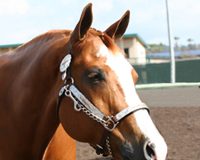Q: I purchased a Haflinger trail horse last year. I only recently (and somewhat accidentally) found out that he is an incredible jumper with perfect jumping form. I’d love to go the hunter/jumper route with him, but he doesn’t do lead changes. How do I teach him?
First, teach your horse to readily pick up both leads directly from the walk. Practicing on a large figure-8, where you can execute a crisp simple lead change in the center, where the two circles connect. This will prepare your horse for the concept of “new direction, new lead.” Be very clear as you apply your aids: create a definite bend in your horse as he starts each circle and press hard with your outside leg, behind the girth, when you ask for the new lead.
Second, be sure your horse travels straight. That’s fairly easy when he’s tracking along the arena rail, but he must also track straight diagonally across the arena, without the rail to support him. To help achieve that goal, you should keep your horse lightly on the bit and moving freely forward from your driving aids (leg pressure). Next, you must be able to adjust your horse’s canter stride. In order to achieve a flying lead change, your horse will have to momentarily collect (shorten) his stride and also engage his hindquarters. He can’t lean on your hands or persistently prefer to carry a strong gallop.
Finally, you should have complete control over your horse’s hindquarters. In many ways, a flying lead change is similar to a split-second leg yield performed at the canter. Flatwork exercises where you re-position your horse’s hindquarters (like side-passing and turns on the forehand) are important preparatory fundamentals your horse needs to know.
Even more important, you must be ready for the task. Before attempting to train your horse to execute flying lead changes, get professional instruction at a stable where you can ride a fully trained schoolmaster. Because the basic cues for flying lead changes are generally the same throughout all disciplines, it doesn’t matter much if you ride a western, dressage or hunt seat lesson horse. A patient instructor can coach you through the step-by-step process of setting up a horse for a flying change. You’ll also learn how to cue a horse to achieve a clean swap. In the long run, it’ll be worth the investment because you’ll be better equipped to work with your own horse.







Great advise, leads are something that are hard for me to learn.
Good to know.
I will have to try this. I’m a barrel racer, so my horse has to know lead changes.
Thanks for the information. Very informative.
I need to try these methods with my mare.
Sounds tricky but I want to do this.